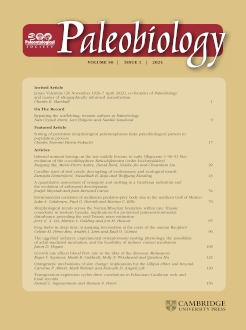The unique body plan of frogs has been largely conserved from at least 200 Myr, and its evolution from a more generalized tetrapod condition is still poorly understood, in part due to the scarce early fossil record of the group. The origin of the frog body plan has been classically explained as an adaptation to jumping, but recent studies incorporating new data in a phylogenetic context have challenged the popular jumping hypothesis. Here we revisit and test this hypothesis from a paleobiological perspective by integrating limb data from a wide range of extant and fossil frogs. We first explored the evolution of limb proportions from the Jurassic to the Paleogene to understand when the present limb diversity originated and whether, and to what extent, limb proportions have been conserved over the last 200 Myr. We then inferred the locomotor capabilities of extinct species, and from these inferences, we studied the frog locomotor diversity over geological time and reconstructed the ancestral state. The evolution of limb proportions is characterized by an early diversification that was underway in the Jurassic, followed by a repeated evolution of a limited range of limb morphologies that were already explored by the Early Cretaceous. In agreement with this early limb diversity, the Jurassic species were also locomotory diverse, and their inferred locomotor modes do not support the jumping hypothesis. We propose that the patterns found herein of repeated convergent evolution of both limb proportions and locomotor capabilities over geological time hamper any attempt to confidently infer the ancestral locomotion mode, and it therefore might be time to start focusing on other hypotheses on the origin of the frog body plan that are not related to locomotion.
The unique body plan of frogs (Lissamphibia: Anura) has been largely conserved from at least 200 Myr, and its evolution from a more generalized tetrapod condition is still poorly understood, in part due to the scarce early fossil record of Salientia, the anuran total-group. The origin of the anuran Bauplan has been classically explained as an adaptation to jumping, but recent studies incorporating new data in a phylogenetic context have challenged the popular jumping hypothesis. Here we revisit and test this hypothesis from a paleobiological perspective by integrating limb data from a wide range of extant and fossil frogs. We first explored the evolution of limb proportions from the Jurassic to the Paleogene to understand when the present limb diversity originated and whether, and to what extent, limb proportions have been conserved over the last 200 Myr. We then inferred the locomotor capabilities of extinct species by phylogenetic flexible discriminant analysis, and from these inferences, we studied the locomotor diversity of frogs over geological time and reconstructed the ancestral state for frog-like salientians. The evolution of limb proportions is characterized by an early diversification that was underway in the Jurassic, followed by a repeated convergence over a limited area of the morphospace that was already explored by the Early Cretaceous. In agreement with this early limb diversity, the Jurassic stem species were also locomotory diverse, and their inferred locomotor modes do not support the jumping hypothesis. We propose that the patterns found herein of repeated convergent evolution of both limb proportions and locomotor capabilities over geological time hamper any attempt to confidently infer the ancestral locomotion mode and, it therefore might be time to start focusing on other hypotheses on the origin of the anuran Bauplan that are not related to locomotion.






